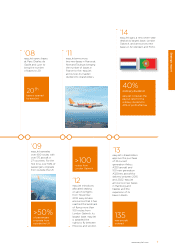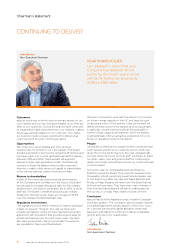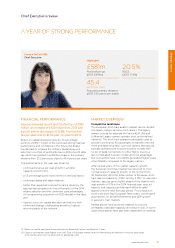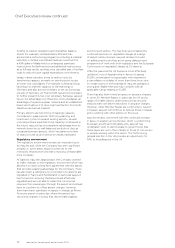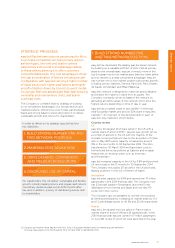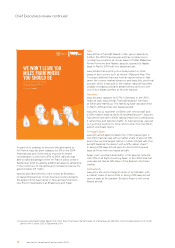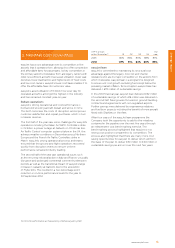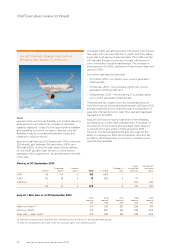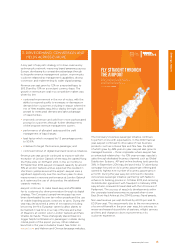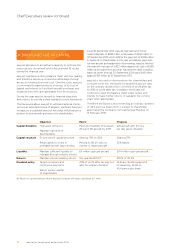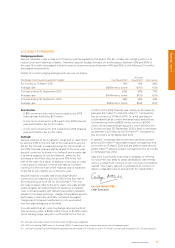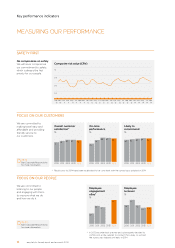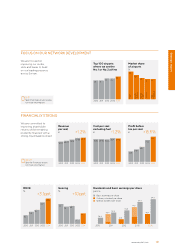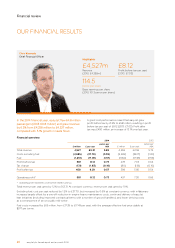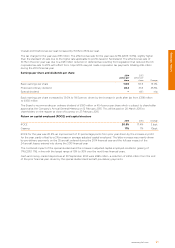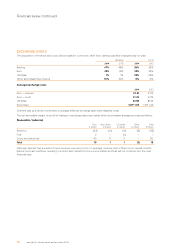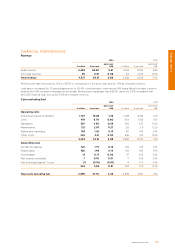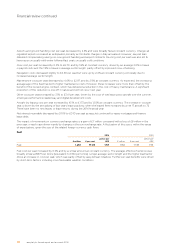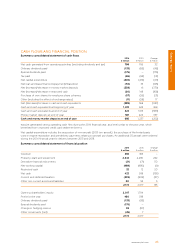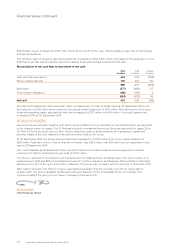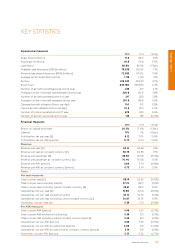EasyJet 2014 Annual Report Download - page 19
Download and view the complete annual report
Please find page 19 of the 2014 EasyJet annual report below. You can navigate through the pages in the report by either clicking on the pages listed below, or by using the keyword search tool below to find specific information within the annual report.
www.easyJet.com 17
Strategic report
LOOKING FORWARD
Hedging positions
easyJet operates under a clear set of treasury policies agreed by the Board. The aim of easyJet’s hedging policy is to
reduce short-term earnings volatility. Therefore, easyJet hedges forward, on a rolling basis, between 65% and 85% of
the next 12 months’ anticipated fuel and currency requirements and between 45% and 65% of the following 12 months’
anticipated requirements.
Details of current hedging arrangements are set out below:
Percentage of anticipated requirement hedged Fuel requirement
US Dollar
requirement Euro surplus
Six months to 31 March 2015 91% 91% 84%
Average rate $958/metric tonne $1.60 €1.19
Full year ending 30 September 2015 80% 85% 77%
Average rate $944/metric tonne $1.59 €1.18
Full year ending 30 September 2016 58% 55% 52%
Average rate $921/metric tonne $1.64 €1.21
Sensitivities
• A $10 movement per metric tonne impacts the 2015
financial year fuel bill by $3.5 million.
• A one cent movement in £/$ impacts the 2015 financial
year profit before tax by £1.3 million.
• A one cent movement in £/€ impacts the 2015 financial
year profit before tax by £1.1 million.
Outlook
easyJet expects to grow capacity, measured in seats flown,
by around 3.5% in the first half of the year and by around
5% for the full year. Forward bookings for the first half of
the 2015 financial year are slightly ahead of the prior year.
easyJet continues to invest in its network and in particular
is growing capacity at London Gatwick, driven by the
purchase of the Flybe slots, by around 10% in the first
half of the year. As a result of easyJet continuing to invest
in and grow its network, revenue per seat at constant
currency for the first half of the financial year is expected
to be flat to very slightly up on the prior year.
easyJet expects cost per seat (excluding fuel and
currency) to increase by around 2.5% for the first half of
the year and by around 2% for the full year(9). The cost
per seat increase reflects the prior year’s unusually benign
winter weather and will primarily be driven by increased
crew costs associated with delivering a resilient operation
ahead of new base openings, charges at regulated airports,
particularly in Germany and Italy, increased navigation
charges and increased maintenance costs associated
with the planned ageing of the fleet.
It is estimated that at current exchange rates and with jet
fuel remaining within a $800 metric tonne to $1,000 metric
tonne trading range, easyJet’s unit fuel bill for the first six
months of the 2015 financial year is likely to decrease by
between £12 million(10,11) and £22 million(10,11) compared to
the six months to 31 March 2014. On a full year basis it
is estimated that at current exchange rates and with jet
fuel remaining within a $800 metric tonne to $1,000
metric tonne trading range, easyJet’s unit fuel bill for the
12 months ending 30 September 2015 is likely to decrease
by between £22 million and £70 million(10,11) compared to
the 12 months to 30 September 2014.
In addition, exchange rate movements are likely to have
around a £5 million(10) favourable impact compared to the
six months to 31 March 2014 and are likely to have around
a £20 million(10) adverse impact compared to the 12 months
to 30 September 2014.
easyJet is successfully executing its strategy of offering
its customers low fares to great destinations with friendly
service so that it will continue to win in a more competitive
market. This means easyJet is well placed to continue to
deliver sustainable returns and growth for shareholders.
Carolyn McCall OBE
Chief Executive
(9) Includes anticipated impact from the recent EU261 Huzar judgement.
(10) US $ to £ sterling 1.5633, euro to £ sterling 1.2540. Currency and fuel increases are shown net of hedging impact.
(11) Unit fuel calculated as the difference between latest estimate of FY’15 fuel costs less FY’14 fuel cost per seat multiplied by FY’15 seat capacity.


